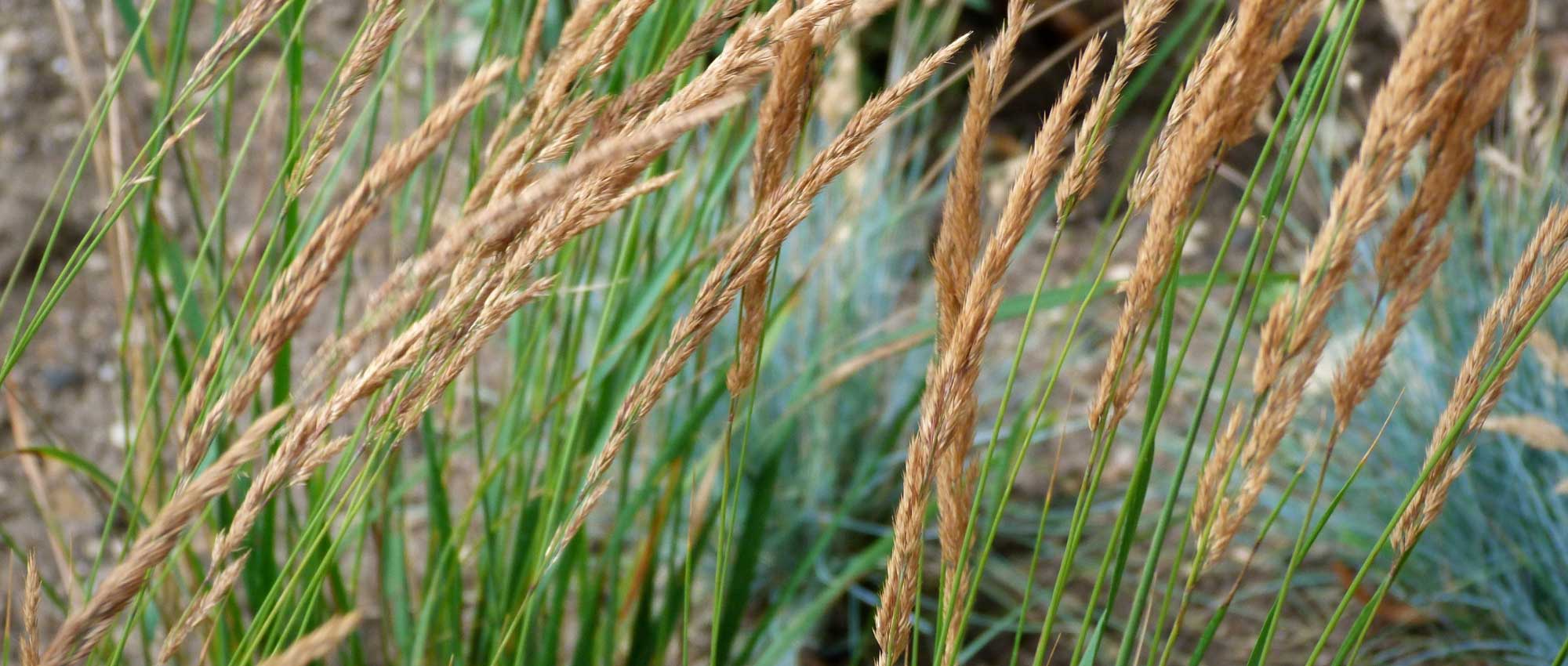
Calamagrostis: planting, growing and care
Contents
Calamagrostis in a nutshell
- Calamagrostis is a tall, structural ornamental grass
- It offers flowering in feathery panicles, in soft, delicate, warm tones
- It is an ideal plant for naturalistic gardens or to add volume and lightness to borders
- It is decorative all year round, even in winter, and its flowering lasts a long time
- It is one of the most popular ornamental grasses; there are even varieties with variegated foliage.
A word from our Expert
Calamagrostis are medium-sized grasses. Majestic, they bear fine foliage topped by feathery inflorescences, in panicles. Calamagrostis take on beautiful, soft, warm colours: beige, light brown, golden, purplish… The most common is the Calamagrostis acutiflora ‘Karl Foerster’, an essential variety offering large light-brown panicles. Calamagrostis brachytricha is also appreciated for its superb, silvery, feathery flowering that shines in sunlight. There are also unusual varieties with foliage variegated with white or yellow!
Calamagrostis is prized for its natural, wild appearance. It is essential for bringing structure and volume to borders! Calamagrostis is a landscaping plant, ideal for large areas, parks and green spaces. It helps recreate naturalistic scenes.
Calamagrostis are almost foolproof plants that can grow just about anywhere. They tolerate any type of soil, even heavy, clay soils, and cope well with dry sites. They thrive in full sun but also grow in partial shade. Calamagrostis is a very reliable, robust, hardy plant that requires almost no maintenance, apart from annual pruning in late winter! It grows quickly, is easy to propagate, and is valuable in the garden all year round… In short, if you haven’t already, Calamagrostis is a plant to add to the garden without delay!
Description and botany
Botanical data
- Latin name Calamagrostis sp.
- Family Poaceae
- Common name Calamagrostis
- Flowering between June and October
- Height up to 1.80 m
- Exposure full sun or light shade
- Soil type ideally cool and well-drained, but tolerates any soil type
- Hardiness between −20 and −25 °C
Calamagrostis are ornamental, perennial grasses that form clumps of decorative, linear foliage and bear flowering in panicles. They number between 260 and 300 species. They are mainly found in temperate regions of Northern Hemisphere, notably Europe and Asia, as far as Russia, but also North America. Several species grow wild in France, such as Calamagrostis arundinacea, Calamagrostis canescens, or Calamagrostis epigejos… The most widely cultivated species are by far Calamagrostis acutiflora, notably variety ‘Karl Foerster’.
Calamagrostis, like many grasses, are robust and very hardy. They can withstand at least between −20 and −25 °C, sometimes more. They are easy, undemanding and long-lived plants.
Calamagrostis belongs to the large family Poaceae, as do grasses used for lawns, cereals we eat (wheat, oats, etc.), and ornamental grasses in gardens (stipa, pennisetum…). This is an immense family with more than 11,000 species. These plants are sometimes confused with Cyperaceae (papyrus, Carex…) and Juncaceae (rushes). They can be rather discreet (small, pale flowers), with simple linear foliage… yet they are of great economic, food, landscape and ecological importance. Poaceae are generally herbaceous plants with linear leaves with parallel veins, bearing very reduced flowers organised in spikelets gathered into panicles (large inflorescences).

Calamagrostis neglecta: botanical plate
Etymologically, the name Calamagrostis comes from Greek Calamus, meaning reed, and Agrostis: grass. It is amusing to note that Calamus (a palm) and Agrostis (a small meadow or lawn grass) are names of two other plants. The specific name acutiflora means “acute-flowered”, probably because its panicles are tighter, finer and narrower than those of other species. Karl Foerster (1874–1970) was a German gardener, landscaper and writer who gave his name to the famous variety. Calamagrostis brachytricha has several synonyms: it is also called Calamagrostis arundinacea, or Stipa brachytricha.
Calamagrostis are fast-growing grasses that form erect, ample tufts. They have a fairly straight shape, with a vertical habit, adding volume. They measure between 60 cm and 1.80 m in height (for 50–60 cm in width), most varieties easily exceeding 1 m. They gain height when in full flowering. Their stems are unbranched, erect, straight or slightly arching. With its majestic silhouette, Calamagrostis brings verticality and acts as a structural element in a border.
Calamagrostis starts growth fairly early in spring. It is interesting all year round: even when it enters dormancy in winter, it remains decorative because it retains its upright, structural form. Cut foliage back to near ground level at end of winter, around February, just before plant begins to produce new leaves.
Calamagrostis are cespitose, forming tufts. A few species (such as Calamagrostis epigejos) have running rootstock, thanks to which they spread.
Calamagrostis offer a long flowering period, from early summer to autumn: depending on variety, flowering occurs between June and October. Flowering of Calamagrostis brachytricha is later, appearing in late summer, around August, and remaining decorative until October–November.
Flowers are gathered in light panicles, borne at tips of erect stems above foliage. These panicles measure up to 30 cm in length and look like plumes (even more so on Calamagrostis brachytricha!). They are beige, bronze or light brown, sometimes slightly purplish. In sunshine they take on beautiful golden or silvery tones. Generally, panicle colour changes somewhat over time, often bronze-pink or slightly purplish at first, then becoming light brown. In Calamagrostis brachytricha, inflorescences are first silvery with pink–purple tints, then turn golden in autumn. Panicle hues are soft and warm, very natural.
Panicles are composed of numerous spikelets, each bearing a single flower. These flowers are tiny, barely visible. They are bisexual and have three stamens (producing pollen) and two feathery stigmas (receiving pollen).
The Calamagrostis brachytricha, also called diamond grass, stands out for its truly feathery, very light inflorescences that shine in sunlight, taking on superb silvery reflections.

Flowering of Calamagrostis acutiflora ‘Karl Foerster’, Calamagrostis rubescens (photo Thayne Tuason) and Calamagrostis brachytricha (photo Dominicus Johannes Bergsma)
Inflorescences are borne above foliage, crowning the clump. They sit at ends of long vertical stems. Panicles are light and sway in wind, bringing movement to garden and animating it. They can also create beautiful effects when they catch sunlight, or under dew or hoar frost. They stay decorative in winter, although snow can bend and flatten stems.
Calamagrostis inflorescences can very well be used in bouquets of fresh or dried flowers.
As with other grasses, Calamagrostis foliage is linear: very long and narrow. Combined with the plant’s height and light, feathery flowering, this makes it very graphic. Leaves are narrow, glabrous, glossy and nicely arching. They measure between 40 and 90 cm in length.
Leaves are generally mid-green, although some species have variegated leaves. For example, cream-striped leaves are seen in variety ‘Overdam’. Calamagrostis ‘Avalanche’ also offers variegated, marginated leaves.

Variegated foliage of Calamagrostis ‘Overdam’ (photo Drew Avery) and green foliage of Calamagrostis acutiflora ‘Karl Foerster’
Calamagrostis take on light brown–yellow tones in autumn, soft warm colours that pair well with autumnal shades of certain trees or bushes (Cornus, Nandina, Acer, Parrotia, Liquidambar…) and perennials.
Like other grasses, Calamagrostis produce fruits called caryopses. Seedheads remain decorative in winter.
Read also
Grasses: which variety to choose?Main Calamagrostis varieties
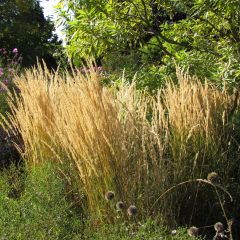
Calamagrostis acutiflora Karl Foerster - Feather Reed Grass
- Flowering time July to October
- Height at maturity 1,60 m
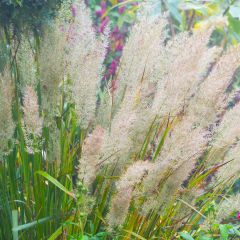
Calamagrostis brachytricha - Feather Reed Grass
- Flowering time September to November
- Height at maturity 1 m
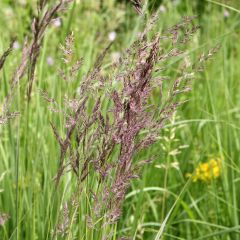
Calamagrostis acutiflora Overdam - Feather Reed Grass
- Flowering time July to October
- Height at maturity 1,20 m
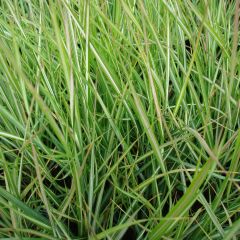
Calamagrostis acutiflora Avalanche - Feather Reed Grass
- Flowering time July to October
- Height at maturity 1,20 m
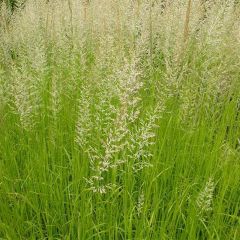
Calamagrostis acutiflora Waldenbuch - Feather Reed Grass
- Flowering time July to October
- Height at maturity 90 cm
Discover other Calamagrostis
View all →Available in 2 sizes
Available in 2 sizes

Available in 2 sizes

Available in 3 sizes
Available in 1 sizes
Available in 2 sizes
Planting
Where to plant?
Plant Calamagrostis preferably in full sun, possibly in partial shade (for example if you live around Mediterranean basin). Calamagrostis brachytricha tolerates shade better than other species. However, in general, when Calamagrostis are in sun their flowering is more generous and their habit more compact, dense and impressive than when in shade.
Ideally, Calamagrostis thrive in humus-bearing, deep, cool or moist soils, but they are nonetheless undemanding plants that have the advantage of being able to grow almost anywhere: they tolerate heavy clay and heavy soils, but also adapt to dry, poor soils. Calamagrostis brachytricha and epigejos, however, need a cooler soil than other species. If substrate tends to dry quickly, plan to water them occasionally. You can also plant these species near a pond.
Calamagrostis can be planted singly (for example on a short grass meadow), or in small groups of three to five clumps to add structure and volume to a garden. You can even plant them in a large group to form a border or hedge, or to create a homogeneous, airy backdrop to a bed. As this is a fairly tall plant that remains decorative throughout the year, you can use it to hide a fence, low wall or barrier. Although it prefers planting in open ground, it is possible to grow Calamagrostis in a large pot or container.
When to plant?
We recommend planting Calamagrostis in spring. However, it is also possible to plant at another time of year; most important is to avoid periods of frost or extreme heat.
How to plant?
We recommend a planting distance of about 60 cm, or slightly less if growing varieties smaller than ‘Karl Foerster’ (such as Calamagrostis ‘Waldenbuch’).
- Place the rootball in a tub filled with water. This rehydrates it.
- Dig a planting hole that should ideally be two to three times the size of the rootball.
- Remove the rootball from its pot, tease the roots lightly, then place it in the planting hole. The top of the rootball should be level with the soil.
- Replace soil around and firm down with the flat of the hand.
- Water generously.
You can also plant Calamagrostis in a large pot or container. Lay a drainage layer in the bottom (gravel, clay balls, broken pottery…), add a light, free-draining growing medium (for example potting compost mixed with a little sand) and plant. Water.
Continue to water regularly for the first few weeks while the plant establishes. Afterwards, it will tolerate drought fairly well.
Discover also our article on planting grasses.
Read also
Planting grassesCare
Calamagrostis tolerate dry soils fairly well and do not need much watering. You can water only during weeks following planting, then occasionally during drought. However, if grown in pots or containers, watering will need to be more regular. Similarly, Calamagrostis brachytricha and Calamagrostis epigejos prefer slightly cooler soil than other varieties and therefore require more frequent watering. You can use mulch to help keep soil cool.
Calamagrostis remain decorative through autumn and winter, but they must be pruned at the end of winter (February–March), just before new growth resumes. Prune hard, cutting clump back to 10 cm above soil.
You can also carry out a light tidy-up in autumn, removing damaged stems or leaves.
If you grow calamagrostis in pots or containers, remember to repot occasionally, preferably in early spring.
Feel free to cut inflorescences for use in bouquets or for fresh or dried flower arrangements.
Like most grasses, calamagrostis is not susceptible to diseases or pests. In every respect (hardiness, soil, diseases, maintenance…), it is a resilient plant that rarely presents cultivation problems!
Multiplication
Like most grasses, Calamagrostis is propagated by dividing clumps.
Dividing clumps
Division is carried out in early spring, when the plant is just starting to resume growth.
- Lift out a clump by digging widely around it and lifting it gently out of the ground so as not to damage its roots.
- Divide it into several pieces. Make sure each piece has roots. Prefer fragments taken from the periphery, on the outside of the clump.
- Prepare soil and replant each new clump.
- Water generously afterwards to help them re-establish.
Monitor the new clumps and continue to water them in the weeks that follow.
If fragments are small, they may take two years to flower.
Combining Calamagrostis in the garden
Calamagrostis fit easily into naturalistic gardens. Use them to create a wild-style garden with an informal look, teeming with life. Create a striking scene by pairing Calamagrostis ‘Karl Foerster’ with Verbena bonariensis and Echinacea purpurea. Also make use of the flower spikes of persicarias or knotweeds! Create a wild meadow with many herbs, grasses, punctate with small colourful flowers (scabious, mallows, poppies, Dierama…). Also discover Salvia nemorosa ‘Caradonna’, with violet flower spikes. You can also create a very natural area near a pond, especially for Calamagrostis brachytricha, which likes cool, moist soil.
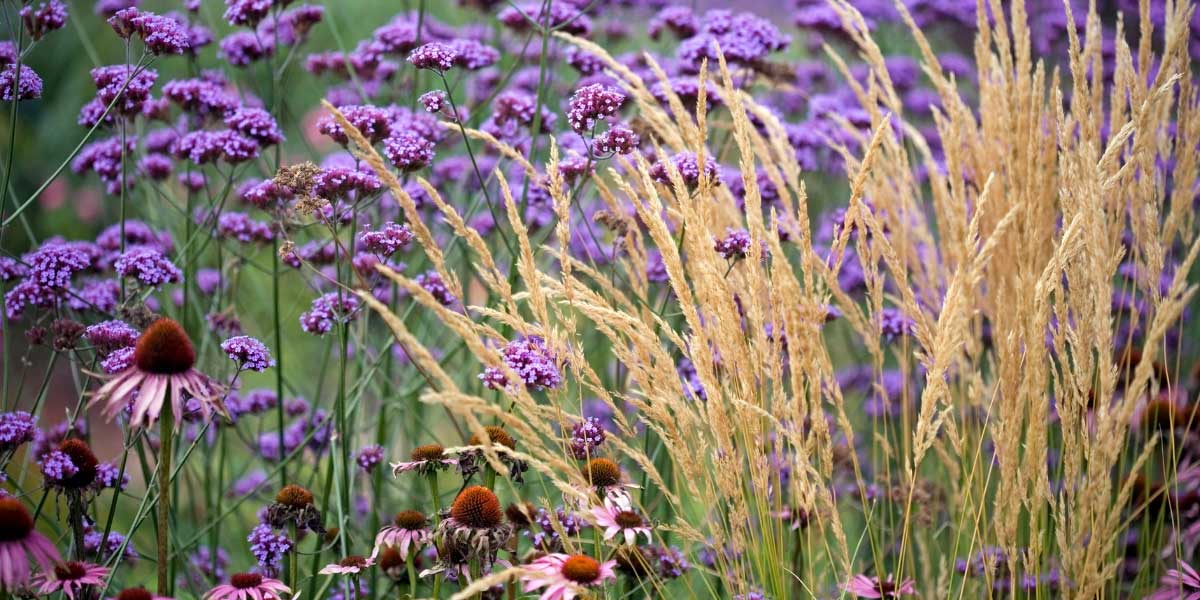
An idea for a natural scene combination: Calamagrostis ‘Karl Foerster’, Echinacea purpurea and Verbena bonariensis (photo GWI – Jenny Lilly – MAP)
With their vertical, light aspect, Calamagrostis also allow creating a graphic, modern garden. These large grasses will help structure a bed. They form upright, tall clumps, adding verticality; use them to play with textures and shapes. Place a few clumps of Calamagrostis alongside lower plants such as alchemillas, heucheras, Ajuga reptans, hardy geraniums, bergenias, carex… Calamagrostis is ideal to lighten a somewhat flat bed and restore volume. Scatter a few clumps among other structural plants such as Eremurus, Agapanthes and Veronicastrums.
Calamagrostis softens stricter forms and straight lines.
You can also use Calamagrostis to design a very light bed with other feathery, airy flowerings! Choose, for example to accompany them, Verbena hastata, Gaura lindheimeri, scabious, Sanguisorba and Perovskia. Enjoy the superb flower spikes of Pennisetum orientale ‘Tall Tails’. Also discover the airy flowering of Thalictrum delavayi, gypsophilas and Dierama.
You can create a superb late-season scene, in autumn–winter, with plants in purple, beige, brown, bronze or orange tones. Choose, for example, Asters, Dahlias, Echinacea ‘Tangerine Dream’, Sedum ‘Autumn Joy’, evergreen grasses… Favour plants with a free, open habit, whose flowers and foliage catch sun rays, frost or raindrops… Plants you can leave in place, whose structure, infrutescences (seedheads) or berries remain decorative in autumn–winter. Choose Echinops, Eryngiums, Dipsacus fullonum, Perovskia, Phlomis… Regarding decorative berries, choose Callicarpa, Symphorines or Euonymus. Also make use of decorative foliage and decorative bark, notably with dogwoods, Nandina domestica or Acer palmatum…
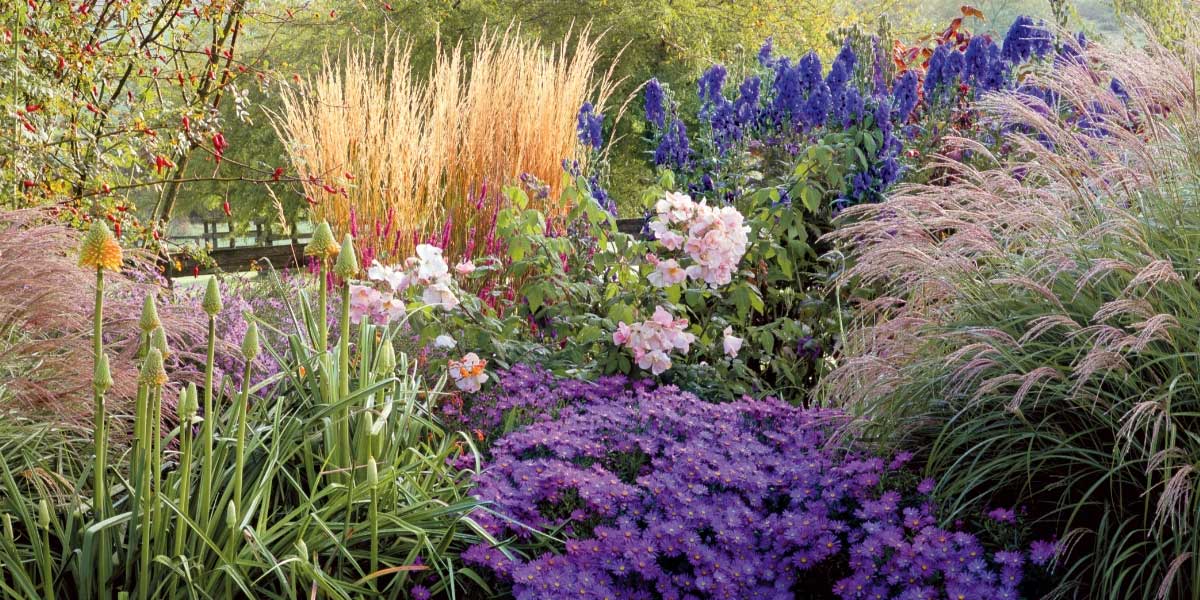
A rather natural autumn scene in soft tones, with Calamagrostis ‘Karl Foerster’, Miscanthus, Aconitum carmichaelii ‘Arendsii’, kniphofias and Aster ‘Violet Queen’ (photo MAP – Clive Nichols – Pettifers Garden Oxfordshire)
Finally, use Calamagrostis to create a low-maintenance garden! They can be used to vegetate a part of garden that is rarely tended because, apart from cutting them once a year at end of winter, Calamagrostis require very little attention. Create a natural area: ecological, water- and labour-saving. Choose other grasses, plants that tolerate drought, groundcovers, and plants that naturalise, returning each year.
Useful resources
-
- Discover our range of Calamagrostis
- Short on inspiration? Discover our ideas for pairing Calamagrostis
- Article by Ingrid on our blog – 10 grasses every garden should have
-
- Our advice – Planting grasses
- Article by Pierre – Time to start pruning grasses!
- Article by Michael – Grasses: those we prune, those we trim
- Discover Christine’s article on feathery panicles
Frequently asked questions
-
Should I prune Calamagrostis?
Yes, but you must wait until the end of winter... it would be a shame to prune it in autumn and not enjoy it during winter. You can cut the clump back around February, just before the plant resumes growth.
- Subscribe!
- Contents
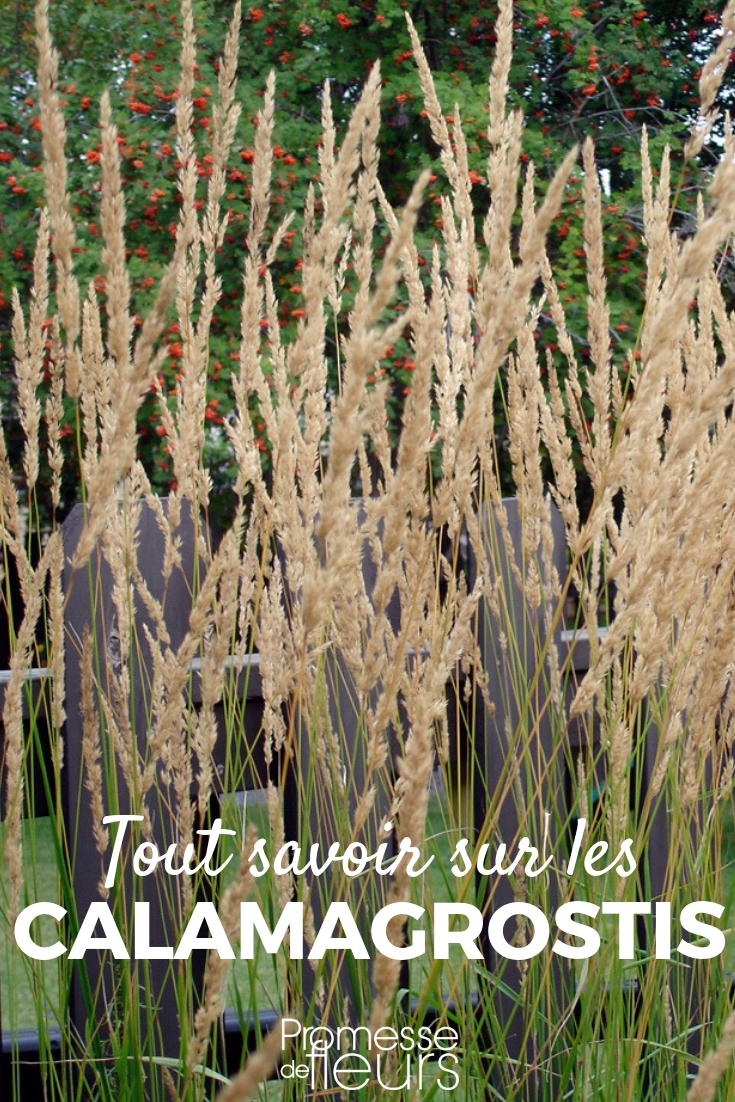

































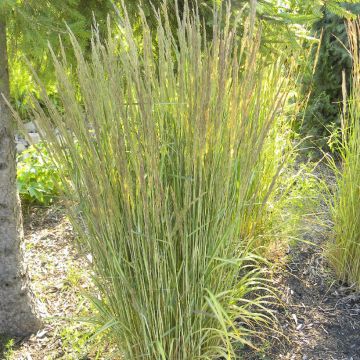

Comments